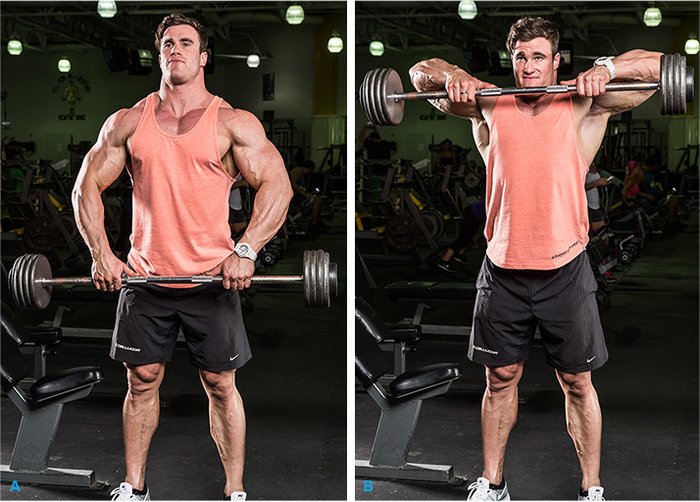Emphasizing your middle delts over the short term can widen your V-taper and give you the illusion of a smaller waist. You may also choose to focus on your middle delts if they're lagging compared to the fronts and rears. If you're looking to build more breadth east to west, here are six strategies to enhance your middles.
1. Train Delts Twice Over the Course of Your Training Split
One easy strategy is to simply train your delts twice over the course of your split. The extra work, done for 6-8 weeks, can help stimulate greater growth.
The problem here is constructing your split so the delts aren't getting overworked. In a worst-case scenario you'd be doing chest on Mondays, delts on Tuesdays, and triceps on Wednesdays (many multijoint triceps exercises like dips and close-grip bench presses also recruit the front delts). Even back training, with its emphasis on rows, works the rear delts.
Instead, insert lower-body or rest days between upper-body workouts if you have a split that runs at least five days. For example:
- Monday: Chest and shoulders
- Tuesday: Legs
- Wednesday: Back and biceps
- Thursday: Rest
- Friday: Shoulders and triceps
- Saturday: Rest
Constructing your split is a bit trickier, but you want to build in at least 48 hours of recovery before hitting a target muscle again, to give it time to grow.
Since you're doing two shoulder workouts each week, consider doing one regular shoulder workout and one abbreviated workout that consists primarily of middle-delt exercises. A workout that includes overhead dumbbell presses, leaning lateral raises, and the lateral-raise machine fits that bill nicely.

Even back training, with its emphasis on rows, works the rear delts.
2. Pick the Right Shoulder Press
Well-conceived mass-building shoulder workouts typically begin with multijoint movements for a good reason: You're able to lift more weight early in your workout when your strength levels are highest. That makes the family of overhead presses your starting point.
While the middle delts are heavily recruited during overhead-pressing work, not all shoulder presses work the middle delts equally. Watch your elbow position relative to your torso. When you press overhead with dumbbells, your upper arms go straight out to your sides; that's your cue that the middle delt is positioned to undergo maximal contraction.
But when you do Arnold presses or barbell presses with the bar in front of your head, your elbows pull forward—they're no longer directly out to your sides. That slight shift recruits the front delts and relieves some of the tension from the middle delts.
While Arnold presses are still great shoulder movements, dumbbell and barbell presses in which you take the bar behind your head will better target the middle delts. Any machine press in which your upper arms travel directly out to your sides will also hit the middle delts more effectively.
Besides zeroing in on the right move, you'll also want to pick a challenging weight. Early in your workout when you're fresh is the best time to challenge yourself; moderately heavy weights for sets of 6-8-reps are ideal. Over the course of your delt workout you can use relatively lighter weights for higher reps, but you'll want that strength stimulus early, which means starting heavy.

Besides zeroing in on the right move, you'll also want to pick a challenging weight.
Avoiding Shoulder Injury
The shoulders are prone to overuse in bodybuilding, and account for some of the most common injuries among weightlifters. Keep these tips in mind to maintain the health of your shoulders:
- Always warm up sufficiently.
- Don't train delts on back-to-back days.
- Avoid movements that cause pain.
- Strengthen the rotators with post-workout rotator-cuff exercises.
- Limit twice-weekly delt workouts to six weeks.
3. Do a Middle-Delt Isolation Move Next
If you've been following a shoulder routine in which you do a single-joint movement for each of the three delt heads after your presses, you're right on the money. But if you want to emphasize a particular portion—in this case the middle delt head—do it first, before your energy levels trail off. After your multijoint pressing move, go right into a single-joint exercise for the middle delts before hitting the fronts and rears.
There are a number of lateral-raise movements to choose from, and each has its particular advantages. In general, a standing movement like a dumbbell lateral raise will enable you to use a bit more body English—helpful to get past a sticking point—and you'll be able to go a bit heavier. Watch for your upper arm going straight out to your side and up; that's what makes the middle delt undergo the greatest contraction.
When choosing a weight, don't go so heavy that you lose form, which is incredibly common with dumbbell or cable lateral raises. Also, going heavy isn't optimal for middle-delt growth—that applies mainly to multijoint movements. With single-joint exercises in which your arm is locked in a slightly bent position throughout the range of motion, extra weight means extra pressure on the elbow joint. Choose a weight in which you can do at least 8 reps with good form.
4. Do a Second Middle-Delt Movement
While a typical shoulder workout consists of just one single-joint movement for each of the three delt heads, there's no reason you can't do another for the middle delt head. While the movement itself doesn't change much, you'll want to make it just a bit different so you're simply not repeating the first move.
To that end, leaning lateral raises allow for a slightly longer range of motion, cable lateral raises allow you to slightly change the angle of pull when you bring your arm out and slightly forward, and single-arm raises allow you to use slightly more focus on each side. You can even do multijoint upright rows, which also engage the middle delts.

You can even do multijoint upright rows, which also engage the middle delts.
But don't stop there. Besides changing the exercise angle, vary the relative intensity as well. So if you do the first middle-delt movement for sets of 8-10 reps, do the second for sets of 10-12 reps. This relatively lighter weight hits the muscle fibers in a slightly different way, resulting in greater overall growth.
5. Don't Stop at Failure

{{caption}}
One of the best ways to beat down those middle-delt muscle fibers is to take multiple sets (but not every one) past muscle failure with advanced training techniques. One of the easiest methods to employ with a single-joint move is a dropset: Once you reach failure, quickly reduce the weight by about 25 percent and immediately continue on with the set to a second point of muscle failure.
It's difficult to complete forced reps with lateral-raise movements, but it can be done on the machine version. You may also try the rest-pause technique, introducing 15-second rest periods intra-set and linking 4-5 work segments.
Save any high-rep "pump" sets until the tail end, when you can really add fuel to the fire. Finish off your delt thrash with a middle-delt exercise combined with an intensity-boosting technique such as dropsets. Keep rest periods short; you've got nothing to save any strength for!
6. Try Unconventional Middle-Delt Moves
The problem with always doing your favorite middle-delt exercise is that you've done it so many times, the muscle has already undergone adaptation. It's important to constantly change some aspect of the stimulus. Introduce some novel angles that are just different enough to encourage a new stimulus for better overall growth.
Seated dumbbell lateral raises are a lot harder than the standing version, because they isolate the muscle better—it's much harder to cheat! You can also try cable lateral raises with the cable running behind your back, which means you'll pull out and back a bit more than if it were in front, which entails more of an out and forward arm movement. And single-arm versions are a great change of pace that allow you to focus on each side individually.

